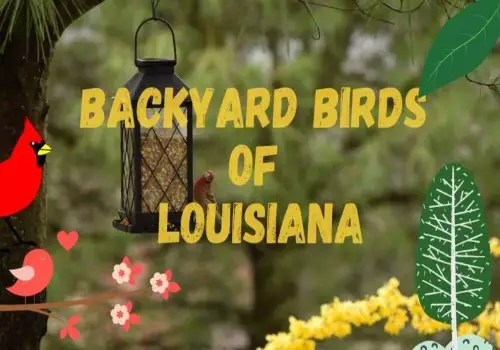How many times do you enjoy bird watching in a month? You might have to do it several times a month in Louisiana to see the over 400 bird species in this state.
What’s even better is…
You can wait for most of these species in your backyard when they pop in for some suet, black oil sunflower seeds, or fruit slices.
In this article, we want to look at the most stunning Louisiana birds that love visiting bird feeders. We'll also tell you what they eat so you can attract more of them. Plus, we'll mention various types of feeders.
Backyard Birds Of Louisiana: What Colorful Species Visit Backyard Feeders?
Installing a bird feeder assures you of bird sightings throughout the day. It's even better when you can name every species that shows up. You can do that when you know how to tell birds by color patterns, body size, and behavior. Let's discover the colorful species you'll see in Louisiana:
1. Red-bellied Woodpecker
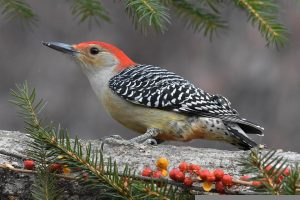
This stunning medium-sized bird is about 9.4 inches long; hence, it's smaller than an American robin. The best place to see this woodpecker is in the woodlands with plenty of hickory and oak trees. Since it comes to backyards, there's no need to find the nearest woodland forest to see this woodpecker.
It eats suet and fruit slices, preferably apple slices if you can leave some in your feeder. Unlike other woodpeckers with black and white stripes, a red-bellied woodpecker has a colorful red nape, black bars on its back, and a whitish belly.
There is a slight difference in plumage between a male and female red-bellied woodpecker because the male has a red crown while the female has a red nape. That's how you tell them about when several of them visit you.
Although this woodpecker's name might have you looking for a bird with a red belly, don't be misled. It has a pale white one.
Red-bellied woodpeckers live in eastern states, from Texas eastward; thus, you'll see them all year round in Louisiana.
2. American Robin
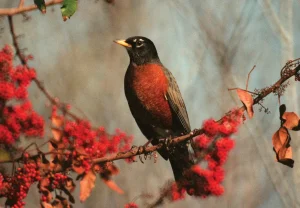
If there's a species you will see everywhere in North America, it's the American robin because it inhabits most of the United States all year round. Robins have a breeding range in the northern area of the continent and wintering grounds south as far as Florida, Texas, and California.
Fortunately, its large population also means it's a backyard visitor. You don't have to look for it in pine or deciduous forests when you can give it some chopped apples in your feeder since robins don't like bird seeds. You may even spot cardinals looking for earthworms.
American robins are medium-sized birds averaging 7.9 to 11 inches long. They might be the largest on your lawn if your bird feeders attract smaller species only. How do you tell there is an American robin around? Look for a bird with a white throat, white patches around the eyes, and a rusty red underbelly contrasting a dark back.
Male and female American robins have the same coloration; however, females are duller.
3. Hairy Woodpecker
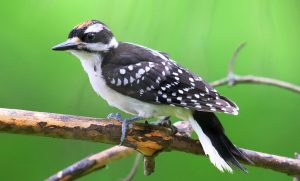
The first thing you notice aside from its black wings with white spots is a red nape and black and white stripes on its head. Hairy woodpeckers live in most parts of North America except for some parts of Texas and California.
In addition to visiting backyards, hairy woodpeckers live in mature forests, cemeteries, and swamps. You find them anywhere there are large trees, including orchards.
To differentiate a hairy from a downy woodpecker, compare the bills, as the shorter one belongs to downy woodpeckers. Another easy way to tell the two species apart is by the outer tail feathers, as downy woodpeckers have spotted ones, while the other species have plain white feathers.
4. Eastern Bluebird
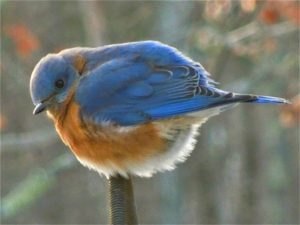
It is a favorite for many backyard birders because where else do you see a bird with a vibrant combination of a deep blue back and a rusty chest? It brings so much color and life to the greenery in your yard. However, you will notice color variations between a male and female eastern bluebird because the color pattern on a female is pale.
In addition to their beautiful bodies, eastern bluebirds are always cheerful, hopping from your feeder to a nest box or trees on your property. Mealworms and berries can keep them longer in your backyard if you notice they leave before you have enough time to take some bird pictures.
On average, their bill-to-tail length is 6.3 to 8.3 inches, which will help you differentiate them from other blue avians that may visit you.
5. Blue Jay
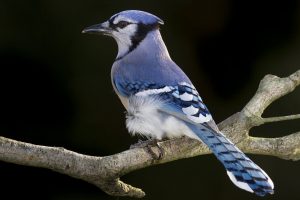
It's another bird with blue feathers. However, a blue jay has a white underside instead of a rusty one, like the eastern bluebird above. Jays also have a black necklace and a striking blue crest. That's how both sexes look, so there'll be no confusion about a pair on your property.
The only thing that may stop you from attracting more jays is their aggressiveness when mingling with smaller backyard birds in Louisiana. But you'll enjoy listening to them as they mimic hawks.
The blue jay inhabits the eastern side of North America, while part of the western serves as the wintering range. It only means one thing: as long as you are in Louisiana, there'll be blue jays visiting your bird feeding station.
Therefore, offer corn, sunflower seeds, or whole peanuts. Yes, the bill of a blue jay can crack open the shell of a peanut.
Blue jays are about the size of robins as they grow between 9.8 and 11.8 inches long.
6. European Starling
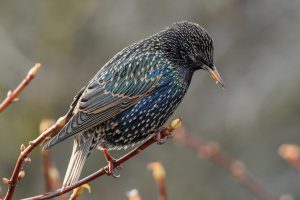
You must have seen European starlings severally as they're common backyard birds throughout North America, wintering south in the Caribbean, Mexico, and California. They are 7.9 to 9.1 inches long, about the size of a robin.
Unlike other birds we'll talk about, European starlings have a green-purple sheen that won't be the most striking in your yard. But their glossy bodies change in winter, and their bills darken. Also, they get some white spots.
Starlings have become a problem to many homeowners because they're invasive. They take over in flocks and eat everything in your bird feeder. You might have to choose between watching their beauty and sending them away when they overwhelm your backyard.
7. American Goldfinch
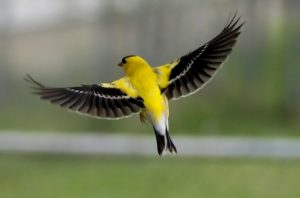
It might be the most colorful in your backyard because of its bright yellow body, black cap, and wings. Although a female goldfinch has a duller body, it still stands out. However, these birds molt in winter to acquire an olive-brown body.
American goldfinches winter in the southern states, so the ones you see in Louisiana are winter birds. The breeding range is north, while the middle States have a resident population.
You may have to set up a separate feeder for American goldfinches because they love nyjer seeds other birds do not like. Give them sunflower, aster, or grass seeds if installing a nyjer feeder is too much work.
An American goldfinch is about half the size of a starling since its body length is 4.3 to 5.1 inches.
8. White-breasted Nuthatch
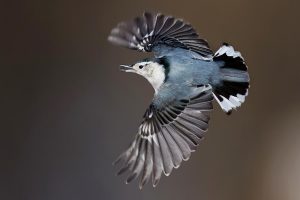
It's not easy to differentiate male birds because they have the same pattern on their dark gray-black backs and white underbellies. But when you look closely, you realize that a male has a black crown while a female has a bluish-gray one.
These tiny birds have a long bill and almost no neck. You'll see them on the eastern side of Louisiana as that's the boundary of the birds' resident range in North America.
They prefer deciduous forests but are also in cemeteries and backyards with woods. If you want to see more white-breasted nuthatches in your backyard, increase your portions of sunflower seeds, mealworms, suet, peanuts, and safflower.
9. Mourning Dove

It's not as colorful as the others we've talked about, but having a few mourning doves in your backyard will give you something else to look at if you've had enough yellow, red, or dark brown feathers of birds on your lawn.
Look for a bird with black spots on its gray wings and a blue eye-ring around black eyes. It also has some unique pinkish legs, and both sexes have the same plumage. Mourning doves are all over the states throughout the year. They come to bird feeders for sunflower seeds, cracked corn, safflower, or millet.
To compare its size with others you see, a mourning dove is medium-sized since its body length is between 9.1 and 13.4 inches.
10. Northern Cardinal
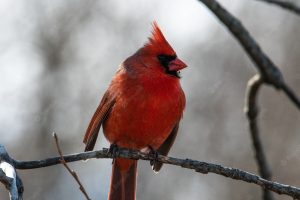
Which of the two sexes do you think is more colorful? Do you prefer the red body of a male northern cardinal or the orange-brown color pattern of the female? Both have a magnificent crest.
Cardinals are in every birding location in the eastern states. There's a resident population in those states, including Louisiana. Cardinals aren't the usual backyard visitors that perch on your bird feeders as they prefer to forage, so they pick fallen seeds.
You can wait for them to help you clear such fallen seeds or give them fresh supplies on a tray or hopper feeder. Also, don't forget to leave a birdbath for them. They love black oil sunflower seeds, corn, peanuts, and safflower seeds.
Northern cardinals are medium-sized because their body length falls between 8.3 and 9.1 inches.
11. Rock Pigeon
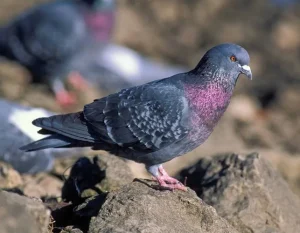
They are so plump that you barely see their short pinkish legs exploring your green lawn. There are varying color patterns, but most of the rock pigeons you see have a bluish-gray head and a gray back with two black bars on the wings.
This species is in love with urban areas because that's where you find it often, not woodlands and grasslands like other species. On top of that, there are rock pigeons everywhere on this continent. That becomes a problem sometimes because they arrive in flocks, leaving no space or food for other backyard visitors.
12. Tufted Titmouse
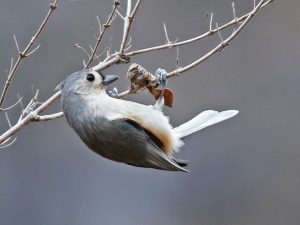
They aren't the most stunning avians on our list of popular birds of Louisiana, but these tiny birds will give you an exciting experience birding in your yard. Why?
They're shy, so find the perfect moment to take a picture of them before they fly into the bushes after grabbing some seeds. When we say they're tiny, we're talking about birds between 5.5 and 6.3 inches long.
Have some peanuts or safflower seeds ready, then wait for a small, grayish bird with a white underbelly and peach flanks. It also has a crest like the northern cardinal. Both male and female titmice have the same coloration.
Louisiana is among the eastern states hosting this species. When it's not near backyard feeders, a tufted titmouse gets its food in deciduous forests or city parks.
13. Ruby-throated Hummingbird
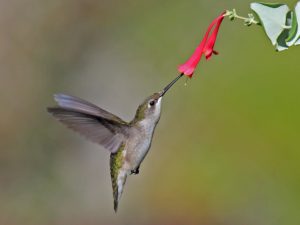
Count yourself among the lucky birders on this continent to spot the ruby-throated hummingbird since it's a migratory bird.
After the breeding season in the eastern states, some birds migrate to Mexico and the southern tip of Florida. Hence, you'll see it in Louisiana in the summer.
The male birds have a shimmering red throat, a black mask, and an iridescent green back. Those aren't the only colors on this hummingbird, as it has a pale gray belly with greenish flanks. Female birds are duller, and their throats are white with green streaks and no mask.
A ruby-throated hummingbird is among the smallest backyard birds in Louisiana as it's 2.8 to 3.5 inches long.
14. Baltimore Oriole
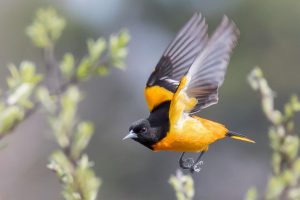
This charming oriole brings its vibrant orange and black plumage to your yard. The males have a black hood and white bars on black wings. Louisiana and other eastern states are in the breeding range, so Baltimore orioles visit in spring.
They inhabit forest edges, woodlands, or swamp edges when there are no bird feeders with fruit slices and nectar water. You rarely find them in deep forests.
20. Pine Warbler
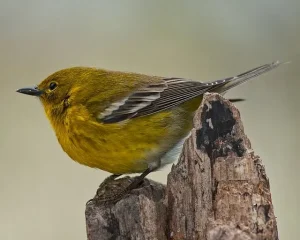
There's nothing like too many yellow birds. So, here's another one that eats peanuts, suet, and sunflower seeds. It eats the most seeds compared to other warbler species.
If pine warblers are on your lawn, you'll see birds with a yellow-olive body, a white lower belly, and a broken yellow eye-ring.
This songbird loves pine trees, hence its name. It's migratory, spending the breeding season in the northern states and wintering around Texas, Louisiana, and Arkansas.
Pine warblers are sparrow-sized because they're 5.1 to 5.5 inches long.
Now, list these birds in your journal and note how often they come to visit your feeders.
Bird Point: How about showing some love for hawks? Check our article about them here -- Hawks In Tennessee: 7 Big Birds To Feel Ultimately Coy About.
Types Of Bird Feeders & Species That Use Them
Some feeders are so easy to install and change their location. Others will have you buying additional supplies like posts and traps to deter predators. Let's describe a few feeders below.
Hopper Feeder
It looks like a small birdhouse, bringing aesthetic value to your backyard.
It's the kind you get when your area rains often because a hopper keeps the seeds inside dry.
But, after the buntings, sparrows, and jays enjoy the seeds inside, their droppings increase the risk of bacteria and wet bird seeds.
Tube Feeders
Most birders start with this design because it's easy to install and has a simple refill and maintenance process.
The seeds stay in a long tube with feeding ports and small perches at the bottom. These small ports deny large birds and predators like squirrels access to the food, which increases the number of small avians in your backyard, as they'll always have food.
These include sparrows, house finches, titmice, and grosbeaks. Remember, the size of the ports determines the type of seeds to add inside.
The downside of a tube feeder is mold and bacteria accumulating in the seeds below the feeding ports. However, you'll not have that problem with a regular maintenance routine.
Window Feeders
You can install a window feeder to keep small birds in one place and feed other birds elsewhere. Such a design suits small sparrows, finches, and chickadees.
It's a great idea when you want to watch birds from inside the house as you mount the feeder on your window with suction cups. It's also easy to refill such a design, and you can monitor the visitors and predators.
Tray Feeder
It's also called a platform feeder, and this design feeds the most avians, from house sparrows to pigeons.
It draws ground-feeding birds like northern cardinals. However, it's also open to predators like raccoons and squirrels until you raise it and add a squirrel baffle.
Suet Cage
It has a mesh casing that holds the suet cake. You can nail the cage to a tree or suspend it from a branch. Alternatively, attach it opposite another feeder design when using a shepherd's hook.
Suet cages feed many species, including jays, titmice, woodpeckers, and nuthatches.
Using a suet cage with a bottom hole is also a great tactic to deter invasive species like starlings because these birds don't hang upside down, so it's difficult for them to use such feeders.
A problem noted by some birders is the risk of injury when the cage traps the bill or limbs of small birds. Nevertheless, a regular birder notes when suet cages need maintenance and repairs any wires that may injure birds.
Watch This!
Frequently Asked Questions
What is the rarest bird in Louisiana?
The whooping crane was absent in this state for 60 years until its reintroduction in 2011. There were only two such cranes in 1945 in this state. By 2019, North America had less than 1,000 whooping cranes.
How many species of birds are there in Louisiana?
Over 470 species live in this state, making it an excellent place to explore as a bird lover.
Does Louisiana have finches?
Yes, it does. We mentioned the American goldfinches earlier, and you'll also see the pine siskin, house finch, and red crossbill, among others.
What are the large white birds in Louisiana?
You might be referring to the great egret as it has a resident population in Louisiana. It has a white body, an s-curved neck, and black legs. If not, then maybe you saw the cattle egret that inhabits southern Louisiana throughout the year and breeds in the northern area.
Other birds in Louisiana with such plumage include the white ibis, snowy egret, snow goose, and the American white pelican.
Conclusion
Now that you want to see the colorful birds we've listed above, it's time to find feeders appropriate for them. You may have to install several designs to suit birds of different body sizes and their varying feeding habits.
Some species, like rock pigeons and European starlings, will arrive in flocks, while others, like titmice, will grab seeds and enjoy them elsewhere.

